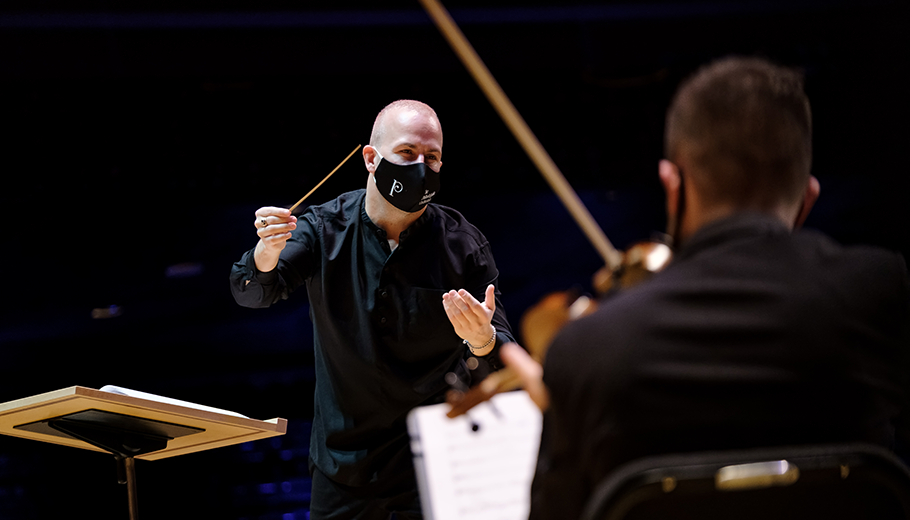5 Insights From Our Platform Open Houses
As a follow up from our recent signature research initiative, Demystifying Digital Content Monetization, we were delighted to host two open house sessions for our members to meet with a variety of video platform vendors. During these calls, we also had the opportunity to hear from arts organizations who partnered with these companies and learn about their experiences going digital.
We’ve gathered five key takeaways from our engaging panelists, including platform representatives and arts leaders, across the two sessions.
“Fire, Hope, and Truth” at Philadelphia Orchestra
Image courtesy of Philadelphia Orchestra
Getting Started Is Easier Than It Seems
As we heard from arts organizations throughout our research on digital monetization, often just figuring out how to get started with online programming can be the most daunting element of going virtual. Fortunately, our participants all emphasized that not much is required to kick off a digital venture.
Kara Henry, Director of Marketing & Communications at Steppenwolf Theatre Company emphasized how easy it was to create a clearly branded landing page with SproutVideo for her organization’s digital membership. Without in-depth expertise in any sort of programming, she was still able to build out a site that was just customized enough for Steppenwolf’s needs (and without a heavy financial investment). Courtney Purchon, Head of Marketing at SproutVideo, also highlighted options on the backend of using the platform, including integrations with Tessitura, Zapier, and a variety of other payment technologies.
PJ Taei, Founder & CEO of UScreen, echoed this sentiment for his own platform. When asked by a member in attendance how much content would be needed to get started building out a digital streaming site, he explained that just a few hours of content are enough to get started -- the aim is just to be able to fill up your front page. Beyond that, only some thumbnails and a logo will be sufficient to create a fully branded experience for your audience. started, just enough to fill the page, so a few hours of content is enough to get started.
For Jennifer Buzzell, Director of Marketing & Sales at Signature Theatre, ease of use was her top priority when choosing a platform to partner with. Like many of our other panelists, her selection process involved many spreadsheets comparing costs and features. It was the ability to quickly get set up and access features that were important to her, like allowing streaming to Roku and reaching built-in audiences, that ended up leading her to work with Marquee TV.
“Duchess! Duchess! Duchess!” at Steppenwolf Theatre Company
Image Credit: Lowell Thomas (courtesy of Steppenwolf Theatre Company)
Building Productive Technical Partnerships
One benefit of working with these video vendors that we heard across the board from our participating arts leaders was the ability to have a technical partner as they moved into this new digital space.
Kory P. Kelly, Director of Marketing & Communications at Pasadena Playhouse, shared that the theater had been considering digital content before, but that this process was accelerated in the pandemic -- as he noted, “nothing sparks innovation like necessity.” While jumping into digital was daunting with so many aspects to consider in their planning, he appreciated being in close contact with at least five members of the team at UScreen, his digital platform partner, for help on anything related to their video streaming. This relationship allowed Kory and his team to take full advantage of the platform even with their free offerings, as UScreen showed them how to capture useful data for any viewer of their content.
For Rebecca Kier, Senior Managing Director of Individual Giving at the Philadelphia Orchestra, having an external technical partner was crucial. She is working with sister companies Broadway Unlocked and All Together Now, which specialize in innovative virtual events, to plan a digital fundraiser. While the Orchestra has a fantastic IT team, Rebecca recognized that handling the truly interactive, flexible event she envisioned would be beyond everyone’s bandwidth -- especially with the need to provide high levels of stewardship to donors while the fundraiser is taking place. Having a team completely focused on fixing any technical issues that may arise is a huge relief, allowing the Philadelphia Orchestra team to give their full attention to hosting a great event.
At Marquee TV, partnership is inherent in the model, Head of Product Marc Kirschner shared. As a commercial platform and aggregator of arts performances, they do not view themselves as a service but rather seek partners in the arts to join them in the work that they do in the digital sphere. With their own audience lists and marketing efforts, they look for arts institutions who will be able to work and grow along with them, which is evident in their revenue sharing model.
“SIMPLY SONDHEIM” at Signature Theatre
Image credit: Christopher Mueller (courtesy of Broadway World)
Securing Rights: An Early Start Is Key
As Marc noted, rights are always tricky. He recommends starting as early as possible, ideally before production, to understand which music, Equity/SAG, or brand rights you might need to create and distribute a digital performance. This will give you the necessary time to resolve any potential hiccups.
Steinunn Birna Ragnarsdóttir, Artistic Director and CEO of the Icelandic Opera, echoed this sentiment based on her own experience during the pandemic. While her work with OperaVision, a freeview platform managed by Opera Europa, was completely positive, a publisher reluctant to grant access for streaming ended up causing a major delay in the final greenlight of her project. This in turn led to high costs. She highly recommended working to secure those rights before a project began.
That said, when asked if she would do it all over again in digital, Steinunn wholeheartedly agreed that she would -- even if it cost twice as much. Despite all the challenges, she feels that this is the age of change, and it is worth the hurdles to move along in this innovative (and more climate-friendly) direction.
“Brothers” at Icelandic Opera
Image credit: Johanna Olafsdottir (courtesy of OperaVision)
Using Metrics To Inform Digital Strategy
With many arts organizations experimenting in digital for the first time (or at least in new ways), the ability to measure success is key.
Kara shared some of the data analytics she and her team at Steppenwolf were able to leverage through her partnership with SproutVideo -- and how this helped to shape strategy. Some of the findings included:
Individuals who only purchased a digital membership were much more likely to engage with the content than existing subscribers (who received free access to the virtual offerings), so the Steppenwolf team made sure to reach out directly to subscribers to remind them about interesting new digital content on the site.
Audiences tended to be more engaged at certain times of the day or week, so she made sure to focus limited marketing resources towards those times.
When she refreshes their communications with positive press, she has seen a noticeable uptick in views.
Releasing a new show leads to bumps in viewership of the previous releases as well.
Kory from Pasadena Playhouse shared that the metrics he gained from UScreen helped him to really readdress the model in which they thought they were going to operate. Going in they considered a membership model, but quickly realized that they did not have the capacity to maintain the level of new production of digital content that would allow them to sustain this structure. By moving to a pay-per-view model they could garner high levels of interest (and capture data) with their free offerings, and were then able to track how these audiences were then drawn to participate in paid offerings.
“Still” at Pasadena Playhouse
Image courtesy of Pasadena Playhouse
Leveraging Digital Content for Donations
As we learned in our research on digital monetization research, online content can be an effective way to bring in contributed income through requests for donations.
This was particularly top of mind for Rebecca at Philadelphia Orchestra as she plans her upcoming digital fundraiser, which will be a key opportunity to connect with the global audience they have developed this past year.
Her partners in this event, Broadway Unlocked / All Together Now co-founders Jess Ryan and Joe White, shared their thoughts on how best to tie a donation request to a virtual event. There are opportunities at each stage of a virtual gala or performance to ask for a donation. More important is to create a sense of space -- “design a destination” -- so that digital attendees feel a sense of urgency in having this immediate opportunity to give.
Luke O’Shaughnessy, Project Manager of OperaVision, shared that donations are a potential direction for the future. While in the pandemic the priority of developing the platform was to increase access to the art form and to allow opera companies to share their work during closure, he could see framing a suggested donation on the site as a way of showing the support for the company and the art form.
To watch the full replays of each meeting and view informational materials for all our participating platforms, visit our Platform Open House home page here.






